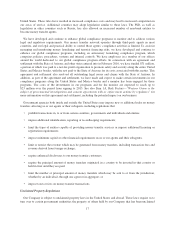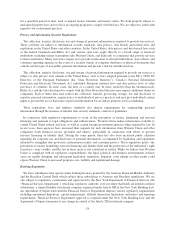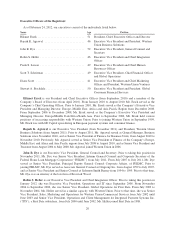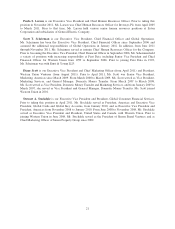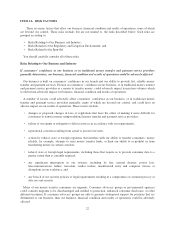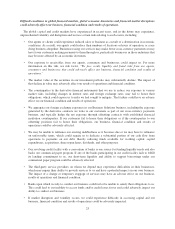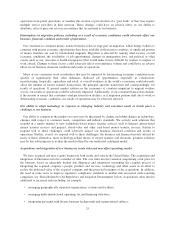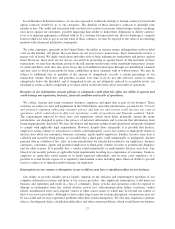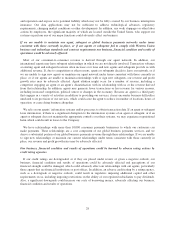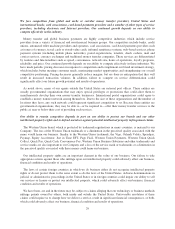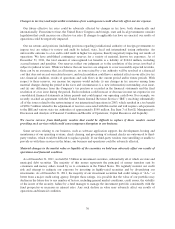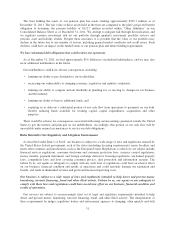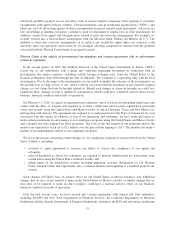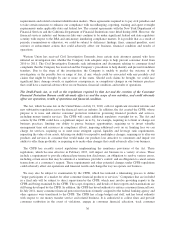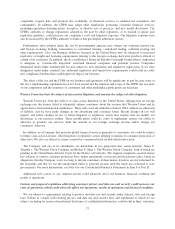Western Union 2011 Annual Report Download - page 34
Download and view the complete annual report
Please find page 34 of the 2011 Western Union annual report below. You can navigate through the pages in the report by either clicking on the pages listed below, or by using the keyword search tool below to find specific information within the annual report.In our Business Solutions business, we are also exposed to credit risk relating to foreign currency forward and
option contracts written by us to our customers. The duration of these derivative contracts is generally nine
months or less. The credit risk associated with our derivative contracts increases when foreign currency exchange
rates move against our customers, possibly impacting their ability to honor their obligations to deliver currency
to us or to maintain appropriate collateral with us. If a customer becomes insolvent, files for bankruptcy, commits
fraud or otherwise fails to pay us for the value of these contracts, we may be exposed to the value of an offsetting
position with a financial institution counterparty.
We offer consumers, primarily in the United States, the ability to transfer money utilizing their credit or debit
card via the Internet and phone. Because these are not face-to-face transactions, these transactions involve a
greater risk of fraud. We apply verification and other tools to help authenticate transactions and protect against
fraud. However, these tools are not always successful in protecting us against fraud. As the merchant of these
transactions, we may bear the financial risk of the full amount sent in some of the fraudulent transactions. Issuers
of credit and debit cards may also incur losses due to fraudulent transactions through our distribution channels
and may elect to block transactions by their cardholders in these channels with or without notice. We may be
subject to additional fees or penalties if the amount of chargebacks exceeds a certain percentage of our
transaction volume. Such fees and penalties escalate over time if we do not take effective action to reduce
chargebacks below the threshold, and if chargeback levels are not ultimately reduced to acceptable levels, our
merchant accounts could be suspended or revoked, which would adversely affect our results of operations.
Breaches of our information security policies or safeguards could adversely affect our ability to operate and
could damage our reputation, business, financial condition and results of operations.
We collect, transfer and retain consumer, business, employee and agent data as part of our business. These
activities are subject to laws and regulations in the United States and other jurisdictions, see risk factor “Current
and proposed regulation addressing consumer privacy and data use and security could increase our costs of
operations, which could adversely affect our operations, results of operations and financial condition” below.
The requirements imposed by these laws and regulations, which often differ materially among the many
jurisdictions, are designed to protect the privacy of personal information and to prevent that information from
being inappropriately disclosed. We have developed and maintain technical and operational safeguards designed
to comply with applicable legal requirements. However, despite those safeguards, it is possible that hackers,
employees acting contrary to our policies or others could improperly access our systems or improperly obtain or
disclose data about our consumers, business customers, agents and/or employees. Further, because some data is
collected and stored by third parties, it is possible that a third party could intentionally or negligently disclose
personal data in violation of law. Also, in some jurisdictions we transfer data related to our employees, business
customers, consumers, agents and potential employees to third-party vendors in order to perform due diligence
and for other reasons. It is possible that a vendor could intentionally or inadvertently disclose such data. Any
breach of our security policies or applicable legal requirements resulting in a compromise of consumer, business,
employee or agent data could require us to notify impacted individuals, and in some cases regulators, of a
possible or actual breach, expose us to regulatory enforcement action, including fines, limit our ability to provide
services, subject us to litigation and/or damage our reputation.
Interruptions in our systems or disruptions in our workforce may have a significant effect on our business.
Our ability to provide reliable service largely depends on the efficient and uninterrupted operation of our
computer information systems and those of our service providers. Any significant interruptions could harm our
business and reputation and result in a loss of consumers. These systems and operations could be exposed to
damage or interruption from fire, natural disaster, power loss, telecommunications failure, terrorism, vendor
failure, unauthorized entry and computer viruses or other causes, many of which may be beyond our control or
that of our service providers. Although we have taken steps to prevent systems disruptions, our measures may not
be successful and we may experience problems other than system disruptions. We also may experience software
defects, development delays, installation difficulties and other systems problems, which would harm our business
27


